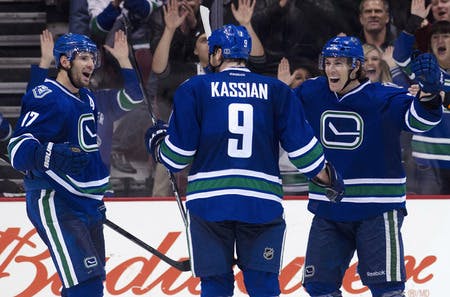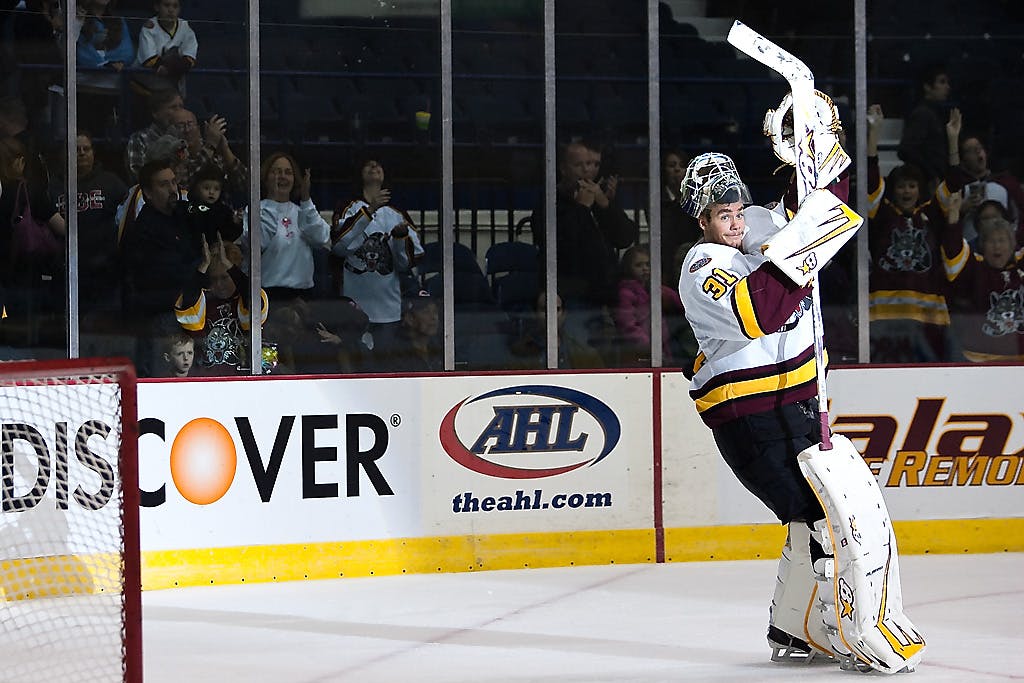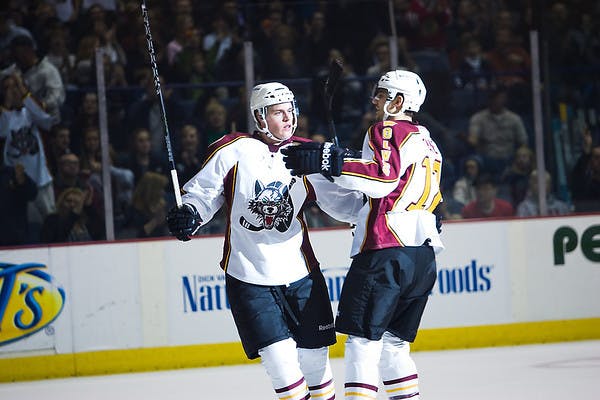3 Canucks Prospects Who Will Benefit from an NHL Lockout

Lost in the din of Doan decision day and Alex Burrows’ four year, 18 million dollar extension – was news that the Canucks re-assigned 23 skaters to their AHL affiliate club the Chicago Wolves. Included in the list of re-assigned prospects were guys like Chris Tanev and Zack Kassian, two players who would’ve been locks to make the Canucks’ NHL roster if not for the lockout.
This isn’t a Canucks specific trend. The AHL will be packed with young talent this season, including NHL quality talents like Gabriel Landeskog, Jeff Skinner, Cody Hodgson, Jordan Eberle and maybe even Oliver Ekman-Larsson. This creates a unique developmental situation, since the quality of competition in the American Hockey League is likely to be significantly elevated in the first month (or more) of the season.
Let’s parse through the list of re-assigned players, and look at which Canucks prospects stand to benefit most from additional AHL seasoning.
Zack Kassian
That an NHL lockout and a protracted stint with the Chicago Wolves could prove beneficial for Zack Kassian’s development, is something of a no-brainer. In a short stint with Buffalo’s AHL affiliate early last season, Zack Kassian was absolutely dominant and nearly a point per game player. In the NHL, he often looked lost defensively and produced at a much more pedestrian rate.
Recently Daniel Wagner over at Pass it to Bullis, succinctly explained why Kassian would have more opportunity to develop in Chicago than he would have if he’d begun the season with the Canucks:
The question is, where will the opportunity be? With Chris Higgins and Mason Raymond both angling for more permanent roles in the top-six, along with Danish wunderkind Nicklas Jensen…. That leaves Kassian third line or, more likely, fourth line minutes.Of course, Kassian could impress and out-battle one of the incumbents for a job on the second line, but he’ll be hard-pressed to do so. It seems likely that a return to the AHL might be the best thing for his development, but he wouldn’t stay there long if he played at the same level he did in Rochester.That’s why a lockout might be the best thing for Kassian’s development. With no NHL to be called up to, Kassian could settle into a top-line role with the Chicago Wolves, where he could play big minutes alongside players with a more offensive bent. Instead of playing 12 minutes with Maxim Lapierre or Manny Malhotra, he could play 20 minutes with Jordan Schroeder and Anton Rodin.
If the NHL season was likely to start on time, Zack Kassian would’ve probably plugged into the Canucks’ bottom-six and most likely the fourth line on the NHL roster. With an NHL lockout, however, Kassian will spend the duration of the labour stoppage getting first-line minutes (and probably favourable zone-starts) in Chicago. Long-term, that could be a big win for both player and team.
There’s another wrinkle here that I want to discuss briefly. The trade that brought Zack Kassian to Vancouver and shipped fan favorite Cody Hodgson to Buffalo; probably represents the most controversial decision Mike Gillis has made in his tenure as general manager. In a hockey mad market already famous for the soul-crushing expectations the fans and media hold the Canucks too, Zack Kassian has the added pressure of "living up to Hodgson." And it’s hard to "live up" to anyone’s expectations on an Alain Vigneault fourth line.
Playing with the Wolves, in a more talent-laden than usual American Hockey League, gives Kassian a chance to develop in a better environment. He can make mistakes (that Canucks fans won’t see) and work on his game (which, Canucks fans won’t watch) without the constant scrutiny that comes with wearing a Vancouver Canucks sweater.
In fact, an NHL lockout was probably the only way Kassian was going to play in the AHL again without being labelled a "bust" and incurring the wrath of Team 1040 callers. He’s definitely the big winner here.
Eddie Lack

In 2011-12, Eddie Lack built on his stellar AHL rookie campaign with a tantalizing sophmore performance. He struggled with his consistency in the middle part of Chicago’s schedule, but he put himself back together, and posted an impressive record and exceedingly strong numbers overall for the Wolves.
Most impressively: Eddie Lack finished the season as the best goalie in the American Hockey League at stopping pucks that were shot by NHL quality shooters. His numbers are more tantalizing, than his cut body! Lack’s success against NHL quality shooters last season is good news because he should face significantly more of them in Chicago this year.
With the Roberto Luongo situation lingering, Lack’s precise role on the team is in "flux" to some extent. The structure of his recently signed contract (first year is a 2way deal, the second is a 1way deal), however, indicates that the organization would’ve preferred to see Lack spend a full season in the AHL regardless of what happens with Luongo or the NHL lockout.
Earlier this summer, I exchanged e-mails with Kevin Woodley of InGoal Magazine, and asked in particular about Lack’s NHL readiness (should a Luongo trade go down). Woodley thought that while, there is "certainly value to playing games and being in more and more live situations," Lack’s development wouldn’t necessarily be "hurt" by spending a season watching sixty NHL games from the bench.
"Having [Rollie Melanson] as a full-time goalie coach negates" some of the issues that young backup goaltenders run into, Woodley adds, in part because, "Melanson does such a good job creating game-like situations in practice (something many goalies have pointed out to me) should allow Lack to flourish even if he isn’t playing regularly."
Basically Eddie Lack has developed to the point where he is arguably ready for regular duty in the NHL. But that point is still "arguable," because he’s yet to actually appear in an NHL regular season game and hold his own. For a team like the Canucks, who fancy themselves a contender, you probably want someone more experienced on the bench should Cory Schneider "cramp up" in a critical moment.
That said, there’s nothing left for Lack to prove at the AHL level. So if you’re Dave Gagner (the head of player development for the Canucks), you probably don’t want to thrust Eddie Lack into twenty NHL games next season. And yet he’s gotten too good for the AHL, so what to do?
Well the perfect scenario would be if there was a league that was like the AHL, but with slightly better players trying to score against your top goaltending prospect. Luckily for the Canucks, that’s exactly the situation Eddie Lack finds himself in.
Chris Tanev

As we’ve already noted, Kassian and Lack will benefit from some extra time in the AHL for multi-faceted reasons. For Chris Tanev it’s a lot more straight forward and can be summed up with one technical term: ice-time.
As one of two right-handed shots on Vancouver’s blue-line, Tanev was a slam-dunk to make the Canucks’ opening day roster out of training camp. Over parts of two seasons, Tanev has proven to be a possession beast, though he’s still not big enough to regularly handle tougher top-four minutes. If there was not NHL lockout, Tanev would have been pencilled onto the third even strength pairing, alongside Keith Ballard. He’d have rarely sniffed the ice on special teams.
In the AHL, Chris Tanev will probably be reunited with Kevin Connauton (who he played with last season) and he’ll play in all situations. With Nolan Baumgartner retiring, there’s a lot of tough minutes to go around and you can trust Scott Arniel to rely on Tanev to shutdown the opposition’s top players (and those players will, probably, be NHL quality players). More importantly, Tanev be a staple on the penalty-kill and hopefully the first unit power-play.
That power-play time is critical, I think. Tanev’s defense and puck possession abilities are beyond doubt – he’s uncannily efficient in his own end of the rink, and he moves the puck well through the neutral zone. In the offensive end, however, he takes a bit off the table. In particular, he’s too hesitant to shoot the puck and his shot lacks the power and "bite" that you’d like to see from a top-four defenseman in the AHL.
Early this summer, Tanev spoke with Jim Jamieson about honing that particular part of his game:
“I’m always looking to pass first and sometimes if you’re looking to pass and nothing is there, by the time you want to shoot there’s no lane there. There’s definitely a lot of reinforcement from myself and the people around me to shoot the puck once in a while.When guys know you’re going to shoot it, usually that’s when the passing lanes will open up. It’s something I have to get better at and I’ll definitely be doing that more once camp starts."
Surprise, surprise – Tanev even specifically talked about how, he thinks, his offensive game is progressing in part because he got more power-play time in the AHL early last season:
"The numbers might not show it but in the AHL I did a lot better playing on the power play and put up some decent numbers there. When I was up in the NHL I feel like I had a ton more chances than I did in my first year. I just failed to capitalize on them."
Over the next month or two (or longer, but we hope not) Chris Tanev will have a prime opportunity to continue to develop his offensive game and show off that improved shot he’s been working on. One thing is for sure: he’ll have ample opportunity in Chicago.
Recent articles from Thomas Drance





